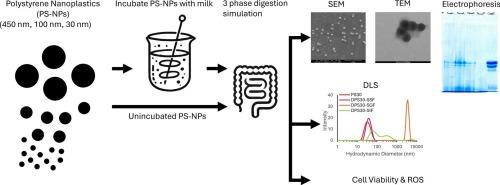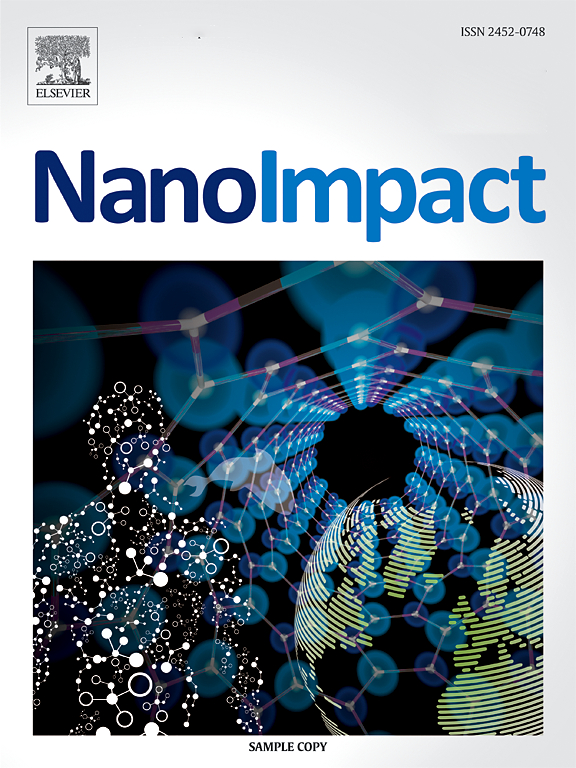探讨真实食物基质在模拟消化过程中对聚苯乙烯纳米塑料的行为和毒性的作用。
IF 5.5
3区 环境科学与生态学
Q2 ENVIRONMENTAL SCIENCES
引用次数: 0
摘要
纳米塑料是一种新兴的污染物,可以通过食物进入人体,引起人们对其潜在健康影响的担忧。其中,聚苯乙烯纳米塑料(PS-NPs)由于其广泛应用于食品接触材料和明确的物理化学性质,经常用于毒理学研究。在这项研究中,我们研究了PS-NPs在营养相关的真实食物基质(牛奶)存在下模拟胃肠道消化的行为和细胞毒性。采用扫描电镜(SEM)、透射电镜(TEM)、能谱分析(DLS)和XPS对消化前后3种不同尺寸(30 nm、100 nm和450 nm)的PS-NPs进行表征,监测其聚集和电晕结构的变化。我们的研究结果表明,牛奶蛋白和消化酶吸附在PS-NP表面,形成一个复杂的蛋白质冠。在消化过程中,蛋白质冠的聚集行为和组成受颗粒大小的显著影响。消化后,在所有粒径的颗粒上均检测到冠状结构;然而,在30 nm的颗粒中观察到广泛的网状团块。虽然消化过程中牛奶的存在并没有显著改变30 nm和450 nm颗粒的细胞毒性,但它导致100 nm颗粒的细胞活力显著降低。这些结果表明,食物基质在胃肠道环境中显著调节纳米塑性行为和毒性。本文章由计算机程序翻译,如有差异,请以英文原文为准。

Exploring the role of real food matrices on the behavior and toxicity of polystyrene nanoplastics during digestion simulation
Nanoplastics are emerging contaminants that can enter the human body through food consumption, raising concerns about their potential health impacts. Among these, polystyrene nanoplastics (PS-NPs) are frequently used in toxicological studies due to their widespread use in food-contact materials and their well-defined physicochemical properties. In this study, we investigated the behavior and cytotoxicity of PS-NPs in the presence of a nutritionally relevant, real food matrix (milk) under simulated three-phase gastrointestinal digestion. PS-NPs of three different sizes (30 nm, 100 nm, and 450 nm) were characterized before and after digestion using SEM, TEM, DLS, and XPS to monitor changes in aggregation and corona structure. Our findings demonstrated that milk proteins and digestive enzymes adsorbed onto the PS-NP surfaces, forming a complex protein corona. The aggregation behavior and composition of the protein corona were markedly influenced by particle size during the digestion process. Corona structures were detected on all particle sizes following digestion; however, extensive web-like agglomerates were uniquely observed in the 30 nm particles. While the presence of milk during digestion did not significantly alter the cytotoxicity of the 30 nm and 450 nm particles, it resulted in a marked reduction in cell viability for the 100 nm particles. These results suggest that the food matrix significantly modulates nanoplastic behavior and toxicity in the gastrointestinal environment.
求助全文
通过发布文献求助,成功后即可免费获取论文全文。
去求助
来源期刊

NanoImpact
Social Sciences-Safety Research
CiteScore
11.00
自引率
6.10%
发文量
69
审稿时长
23 days
期刊介绍:
NanoImpact is a multidisciplinary journal that focuses on nanosafety research and areas related to the impacts of manufactured nanomaterials on human and environmental systems and the behavior of nanomaterials in these systems.
 求助内容:
求助内容: 应助结果提醒方式:
应助结果提醒方式:


